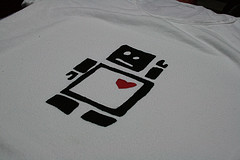 This week Las Vegas once again played host for CES, the Consumer Electronics Show. Bloomberg’s Sam Grobart visited the show and was a little disappointed in the robots that were on display. He felt like many of the robots were clunky and perhaps not even useful in the long run. As he notes in the short video linked above, he had always thought that 2015 would be the year when lifelike robots would be everywhere. Why are we running so far behind?
This week Las Vegas once again played host for CES, the Consumer Electronics Show. Bloomberg’s Sam Grobart visited the show and was a little disappointed in the robots that were on display. He felt like many of the robots were clunky and perhaps not even useful in the long run. As he notes in the short video linked above, he had always thought that 2015 would be the year when lifelike robots would be everywhere. Why are we running so far behind?
This might be a little sci-fi, but maybe we are no longer in a rush to have robot friends because we have turned each other and ourselves into robots to a large extent. As Sherry Turkle points out in her outstanding book, Alone Together, the addition of smart phones to our hands has almost become a Borg-like enhancement. By tapping on a few buttons we can find out what the weather is supposed to be like, make dinner reservations, contact a friend, and buy a gift, all while listening to music. There are apps that enable us to lock up our houses from far away, set the thermostats, and more. We might not have robotic housekeepers like the Jetsons, but the housekeeper app for Androice and iPhone can’t be that far away.
Even more interesting though is how we have turned each other into robots. The 3-dimensional nature of humanity seems to slowly be flitting away in the face of Facebook, Instagram, Twitter, and Google Plus. We ask people from all over the world to bear witness to our lives via images and descriptions. “This is me at my anniversary dinner.” “This is me at my child’s birthday.” The people we are with on these occasions become secondary to the people we are sharing with. The “photobomb” may be simply an attempt to be part of the picture.
Like robots, we are beginning to simplify how we communicate. Although we are not quite using binary code yet, the use of “stickers” on Facebook and emojis elsewhere is a startling separation from the use of actual words. The “like” button on Facebook has become a stand-in for any number of more complex expressions of emotion ranging from, “I see this and I hope you feel better soon” to “I can relate to that” to “I’m really excited for you.” The “heart” button on Instagram and the RT icon on Twitter perform similar tasks, standing in for expressions of verbalized sentiment.
Like robots, we can now turn our friends off and on by turning our phones, our tablets, or our computers off and on. If you do not feel like listening to a friend brag or vent, you can put your phone on silent, walk away from your computer, or put your tablet to sleep. They will never know. They will cease to exist in your mind and will simply assume you walked away. Like a robot, they do not matter as much when you are not interacting with them.
Is this not what the robotic revolution was going to be like?
This article was syndicated from Business 2 Community: Of Robots and Men
More Technology & Innovation articles from Business 2 Community:




